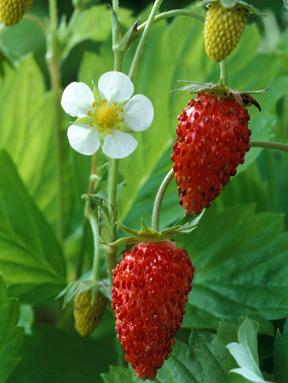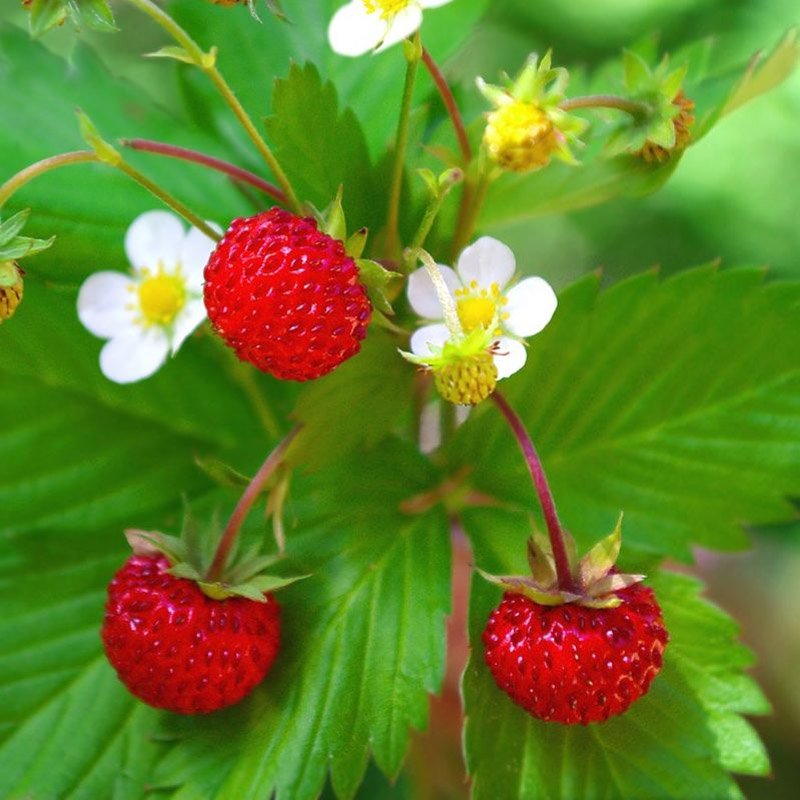New Account | Seed Mix |
Gift Certificates |AAS Winners |
Gardening Products
SEEDS: Unusual | Annuals | Perennials | Vegetables | Herbs | Trees
Strawberry Seeds
Useful gardening information
Select an area of your garden that receives full sunshine as this is one of the main ingredients for a sweet crop. They will grow in areas that are sunny most of the day, but really need full sun to develop to their fullest and sweetest potential. Once planted, strawberries will produce well for three to four years. So, select a location that will not be disturbed. While strawberries like lots of water, they need well drained soil. This is accomplished by creating raised rows. Add fertilizer and compost into the soil and elevate the rows a few inches above the garden soil level. This will allow those heavy spring rains to quench your plants' thirst, but drain away any excess water. Space rows three to four feet apart to allow room to walk and harvest between the rows.Sowing Instructions
Easy to grow in containers, moisture must be maintained and plants should be fed once a week with soluble plant food when fruiting. Cover seeds lightly in warm soil. Keep soil moist until seeds germinate. Will germinate in 21-45 days.Informative articles found on the web:
Easy Strawberry Recipes
Seeds

TWT294 Giant Strawberry
Now you can grow your own huge strawberries at home! Very large fruits with juicy flesh! These large growing strawberries are the largest on the market. Great flavor. Perfect for making chocolate covered strawberries, the kind you pay 30 bucks a dozen for online!

LET776 Basket of Kisses
The perfect berry for hanging baskets! Cascading runners perfect for baskets, white blooms, abundant sweet red fruits.

NB76 Alexandria (Fragaria vesca)
Alpine strawberries from seed.
Day-neutral. These decorative little plants produce delicious, aromatic red strawberries, about twice the size of wild berries but much smaller than the standard type. Perennials, Alpine strawberries stay compact and produce few runners, making them suitable for rock gardens, path edgings, pots, and window boxes. They begin producing the second spring, sometimes the first fall. Grows best in zones 5-8. 100-120 days to bear fruit.
Day-neutral. These decorative little plants produce delicious, aromatic red strawberries, about twice the size of wild berries but much smaller than the standard type. Perennials, Alpine strawberries stay compact and produce few runners, making them suitable for rock gardens, path edgings, pots, and window boxes. They begin producing the second spring, sometimes the first fall. Grows best in zones 5-8. 100-120 days to bear fruit.

LET893 Rugen Improved Strawberry
Improved Rugen is a delicious alpine strawberry. Produces strong, upright plants that are great for rock gardens, border plantings and edible landscapes. Rugen produces smaller, elongated red berries with a sweet flavor. First grown over 250 years ago in France, these Alpine natives grow well in either sun or shade.

3475 Musk Strawberry ( Fragaria moschata )
This is the gourmet fruit with an intense aroma and said to have a taste of its own, likened to strawberries, raspberries and pineapple.
It can be found growing wild in parts of Europe but is not readily available in cultivation.
Fast-growing and withstanding most weather conditions, they make very good ground-cover plants.
The taste is so different than other strawberries that they have been nicknamed Bubblegum Berries by some.
It can be found growing wild in parts of Europe but is not readily available in cultivation.
Fast-growing and withstanding most weather conditions, they make very good ground-cover plants.
The taste is so different than other strawberries that they have been nicknamed Bubblegum Berries by some.

3312 Yellow Wonder
Yellow Wonder Alpine strawberry seeds are a bit easier to start than some others. Start the seeds indoors as early as December, and transplant outdoors one week after your last average frost date. That's around the first or second week in April. With this kind of head start, the plants will produce fruit in the first year. Yellow Wonder has the lovely oblong shape of alpine types, but with yellow skin and flesh and incredible sweetness. The plants are low growing, but very productive, even in containers. The seeds can also be sown later in the year, but plan on harvesting berries from the second year of growth forward.

3438 White Soul Strawberry
Ongoing large white fruits, very sweet with pineapple overtone, runnerless, birds avoid it.

TWT299 Wild Strawberry Groundcover ( Fragaria Vesca Baron Solemacher )
Known as Wild Strawberry, Woodland Strawberry or Alpine Strawberry, this wild Fragaria Vesca is very hardy and a strong grower. This edible, cold tolerant Strawberry is known to have been harvested and eaten by stone-age man, traded from Europe along the Silk Road into Asia. Alpine Strawberry plants have quite a history! Wild Strawberries do not send out runners like other Strawberry plants do, so they are easier to contain and keep them where you desire for them to grow. For zones 4-8, grows about 6 inches tall, produces lots of strawberries.
Indian Strawberry Seeds

SF140 Tuttifrutti Indian Strawberry ( Duchesnea indica )
This rare ground cover plant will get second looks! It's a Strawberry plant with lovely yellow blooms, and it produces small red Strawberries all summer long on a creeping evergreen carpet. Tuttifrutti is well-suited for hanging over a wall or as a ground cover plant.
Duchesnea Indica is naturalized throughout the United States, and it is found growing in shady places in woods and grassy slopes. Prefers a moist, but well-drained soil in a partially sunny position. Once plants are established, the matted root sends out runners to set new plants. Indian Strawberry leaves are light green and finely haired.
The small, yellow flowers are 5 petaled, and first appear in April and will bloom throughout the summer until fall. The fruit is small, about 1/2 inch round. It is edible, but many say the taste is un-noteworthy. Birds, however, love the red fruit. Grows about 5" tall. Hardy to zone 5.
Duchesnea Indica is naturalized throughout the United States, and it is found growing in shady places in woods and grassy slopes. Prefers a moist, but well-drained soil in a partially sunny position. Once plants are established, the matted root sends out runners to set new plants. Indian Strawberry leaves are light green and finely haired.
The small, yellow flowers are 5 petaled, and first appear in April and will bloom throughout the summer until fall. The fruit is small, about 1/2 inch round. It is edible, but many say the taste is un-noteworthy. Birds, however, love the red fruit. Grows about 5" tall. Hardy to zone 5.

